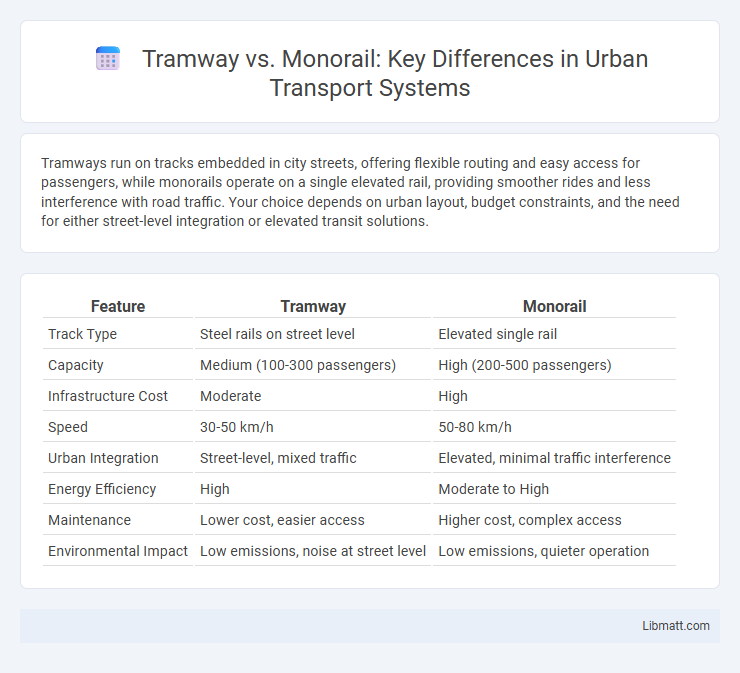Tramways run on tracks embedded in city streets, offering flexible routing and easy access for passengers, while monorails operate on a single elevated rail, providing smoother rides and less interference with road traffic. Your choice depends on urban layout, budget constraints, and the need for either street-level integration or elevated transit solutions.
Table of Comparison
| Feature | Tramway | Monorail |
|---|---|---|
| Track Type | Steel rails on street level | Elevated single rail |
| Capacity | Medium (100-300 passengers) | High (200-500 passengers) |
| Infrastructure Cost | Moderate | High |
| Speed | 30-50 km/h | 50-80 km/h |
| Urban Integration | Street-level, mixed traffic | Elevated, minimal traffic interference |
| Energy Efficiency | High | Moderate to High |
| Maintenance | Lower cost, easier access | Higher cost, complex access |
| Environmental Impact | Low emissions, noise at street level | Low emissions, quieter operation |
Introduction to Tramways and Monorails
Tramways operate on steel rails embedded in city streets, providing flexible urban transit with multiple stops and easy integration into existing infrastructure. Monorails run on a single elevated rail, typically offering faster, grade-separated transit that minimizes traffic interference. Choosing the right system depends on your city's layout, passenger volume, and transit goals, balancing cost, capacity, and urban impact.
Historical Evolution of Urban Transit Systems
The historical evolution of urban transit systems highlights the transition from traditional tramways, which emerged in the 19th century as horse-drawn and later electric streetcars, to monorails introduced in the mid-20th century as elevated, single-rail solutions designed to reduce surface congestion. Tramways played a crucial role in shaping early urban landscapes by providing accessible, ground-level transportation integrated with street traffic, while monorails offered a futuristic alternative with streamlined infrastructure and elevated tracks that minimized interference with existing roadways. The development of monorails was driven by innovations in lightweight materials and automated control, representing a shift toward modern, efficient urban mobility systems.
Design and Engineering Differences
Tramways utilize steel rails embedded in urban streets, allowing them to share road space with other vehicles and pedestrians, while monorails run on a single elevated rail, typically supported by beams or columns for minimal urban footprint. Tramway vehicles are usually lighter, designed for frequent stops and tight city layouts, whereas monorail cars are engineered for higher speeds and smoother rides on exclusive tracks. Your choice between the two depends on the specific design constraints, urban density, and engineering requirements of your transit project.
Capacity and Efficiency Comparison
Tramways typically offer higher passenger capacity due to multiple car configurations and frequent stops in urban environments, enhancing overall efficiency in densely populated areas. Monorails provide moderate capacity with streamlined routes, delivering faster travel speeds and reduced traffic interference, which can improve efficiency in specific corridors. Both systems balance capacity and efficiency differently, with tramways excelling in high-demand city centers while monorails suit medium-capacity transit with fewer ground-level constraints.
Infrastructure Requirements and Footprint
Tramways require extensive track networks embedded in city streets, which involve significant infrastructure modifications and a larger physical footprint affecting road traffic and pedestrian areas. Monorails utilize elevated guideways supported by slender columns, resulting in a smaller ground-level footprint and less disruption to existing urban layouts. Your choice depends on available space and the desired impact on city infrastructure, with monorails offering a space-efficient alternative to traditional tramway systems.
Cost Analysis: Construction and Maintenance
Tramways generally have lower construction costs due to simpler infrastructure, utilizing existing roadways and less expensive tracks, while monorails demand elevated structures and specialized guideways, significantly increasing initial expenses. Maintenance of tramways tends to be more frequent but less costly, as their components are standardized and easily accessible, whereas monorail maintenance involves higher costs linked to advanced technology and limited parts availability. You should consider these factors carefully to balance upfront investment against long-term operational expenses.
Environmental Impact and Sustainability
Tramways typically generate lower environmental impact due to their integration with existing urban infrastructure and use of electricity, resulting in reduced carbon emissions compared to monorails, which often require extensive elevated structures and materials. The sustainability of tramways is enhanced by their ability to support high passenger capacities and promote public transit usage, reducing reliance on cars and lowering overall pollution. You can achieve more eco-friendly urban mobility by choosing tram systems that align with sustainable planning and energy-efficient operations.
Passenger Experience and Accessibility
Tramways offer easy street-level boarding and frequent stops, enhancing accessibility for passengers with mobility challenges and enabling seamless integration into urban environments. Monorails, elevated and often faster, provide a smoother ride with less interference from street traffic, but may require stairs, escalators, or elevators for station access, impacting convenience for some users. Your choice between tramway and monorail systems should consider how accessibility features and passenger comfort align with your city's infrastructure and user needs.
Urban Integration and Land Use
Tramways integrate seamlessly into urban streetscapes by running at street level, allowing easy access and promoting pedestrian-friendly environments that enhance local businesses and reduce traffic congestion. Monorails typically require elevated tracks, which minimize ground-level disruption but demand substantial infrastructure investment and can limit urban adaptability due to their fixed guideways. Your choice between tramway and monorail systems should consider the balance between preserving valuable urban land and achieving efficient public transit connectivity.
Future Trends and Technological Innovations
Tramways are evolving with innovations like autonomous operation and energy-efficient supercapacitors, enhancing urban mobility and reducing environmental impact. Monorails, driven by magnetic levitation and smart control systems, promise higher speeds and quieter rides, making them ideal for futuristic cityscapes. Your choice between these systems can leverage advancements such as real-time data integration and adaptive routing to meet growing transportation demands.
tramway vs monorail Infographic

 libmatt.com
libmatt.com